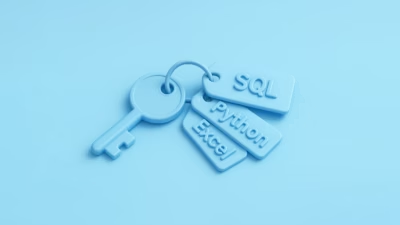Let’s get one thing out of the way: no one is born knowing Python.
Not that guy on LinkedIn with the perfect side-project. Not your colleague who casually drops “vectorized operations” in conversation. And definitely not the data scientist whose blog post you just rage-closed because they started with importing four libraries you’ve never heard of.
Everyone starts from zero. Blank screen, blinking cursor, and a brain full of doubt.
So if you’re thinking, “I want to learn Python for data science, but I have no clue where to start,” you’re in good company.
This guide is your roadmap—built from hard-earned lessons, dumb mistakes, and those weirdly satisfying moments where things finally click. No fluff. Just a clear, honest path to go from “What’s Python?” to “I just ran my first analysis.”
So, Why Python?
Let’s talk about why you’re even here.
Python isn’t just popular—it’s the language of data science. There are others (R, Julia), but Python wins on versatility. One language, and you can clean data, build machine learning models, make dashboards, and automate your coffee order. (Okay, maybe not the last one. Yet.)
But here’s the kicker: Python is also human-readable. It looks closer to English than any other programming language you’ll run into. That means the learning curve? Manageable. As long as you have the right strategy.
Step 1: Get Your Setup Together (No, You Don’t Need to “Install Everything”)
Don’t let setup slow you down. There’s no badge for spending three hours configuring an environment when you could just open Google Colab and start coding right in your browser.
Why Colab?
- No installation required.
- Python + Jupyter Notebooks = built-in playground.
- Supports charts, dataframes, even machine learning models—out of the box.
You’ll hear about Anaconda, Jupyter, VS Code… those are great later. For now? Colab is more than enough. Treat it like your beginner-friendly coding notebook.
Action: Open Colab, create a new notebook, and write:
print("Hello, Data World!")
That’s it. You’ve started.
Step 2: Learn Python Like a Data Person, Not a Developer
This part trips up a lot of beginners.
You google “learn Python” and land in tutorials full of file I/O, web servers, and object-oriented programming. Useful stuff—for developers.
But you’re here for data science. That means your Python learning should orbit around:
- Working with data
- Cleaning data
- Analyzing data
- Visualizing results
So, don’t start by building a calculator or a to-do app. Start by loading a CSV.
Yes, really.
You’ll need to learn:
- Data types: strings, integers, floats, booleans, lists, dictionaries
- Loops & conditionals:
for,while,if,else - Functions: how to reuse code
- Basic error handling:
try,except
But always in the context of data.
Here’s a better first project than “FizzBuzz”:
import pandas as pd
df = pd.read_csv("https://people.sc.fsu.edu/~jburkardt/data/csv/airtravel.csv")
print(df.head())
Boom. You just pulled in a dataset and previewed it. You’re already doing data science.
Action: Practice core Python using Pandas—it teaches you variables, logic, and iteration in context.
Step 3: Learn the Libraries That Make Python Powerful
If Python is the car, libraries are the engine upgrades. These are the tools that turn plain Python into data science Python.
Here’s your short list:
pandas: For data manipulation
Think of Excel, but with 100x the power and none of the mouse clicks.
import pandas as pd
numpy: For numerical operations
It’s under the hood of almost everything. Even if you don’t use it directly much, know that it’s powering a lot of the math.
matplotlib & seaborn: For data visualization
Make charts. Spot trends. Tell stories visually.
scikit-learn: For machine learning
You won’t need this right away—but when you do, it’s magic.
Action: Focus on pandas and seaborn first. If you can wrangle and chart data, you’re halfway there.
Step 4: Build Small, Real Projects That Answer a Question
Here’s something no tutorial tells you: reading code isn’t enough.
You have to build things. Even tiny things.
Start with simple, curiosity-driven projects like:
- “Which day of the week do I send the most emails?” (analyze your Gmail exports)
- “Do movies get better or worse with sequels?” (IMDB dataset)
- “What’s the average air quality in my city this year?” (open environmental APIs)
Projects that make you care about the outcome are easier to stick with.
A Personal Example:
I once wrote a script to check if I was being underpaid compared to Glassdoor salary data. The analysis took two hours. The therapy bills it saved me? Priceless.
Action: Choose a small dataset with a clear question. Don’t aim to impress anyone. Just follow your curiosity.
Step 5: Learn Enough Math to Know What’s Happening
You do not need a PhD in statistics. But you do need to understand a few key ideas so you don’t blindly trust your outputs.
Focus on:
- Averages: mean, median, mode
- Distributions: what your data looks like
- Standard deviation: how spread out your data is
- Correlation: are things moving together or not?
Pandas and Seaborn help here. You can visualize and explore these ideas without ever opening a textbook.
Also, don’t fear the groupby(). It’s where insights hide.
Action: When you learn a new concept (like standard deviation), find a way to visualize it with real data.
Step 6: Embrace the Struggle (And Learn to Google Like a Pro)
Python will break on you. You’ll forget a comma, and nothing will work. You’ll get weird errors like KeyError: 0 or Index out of range. And you’ll want to throw your laptop out the window.
That’s normal.
In fact, it’s part of the job. Knowing how to Google an error, read a StackOverflow thread, and tweak your code until it works—that is coding.
I once spent 40 minutes debugging why my code wasn’t printing anything. Turns out, I’d named my variable print. Yeah.
Action: When you hit a wall, Google the error message exactly as it appears. Add “pandas” or “python” to your search.
Step 7: Add Structure With a Beginner-Friendly Course
At some point, YouTube rabbit holes and blog posts won’t cut it. You’ll want a clear, structured path. That’s where beginner courses help.
But here’s the trick: choose courses that are project-driven and use real datasets. Avoid anything that’s all lecture, no doing.
Great platforms to check out:
- freeCodeCamp (great free content)
- DataCamp (interactive, very beginner-friendly)
- Coursera (especially the IBM Data Science series)
- Kaggle Learn (hands-on and no installation required)
Action: Pick one beginner Python for data science course and commit to finishing it before hopping to the next shiny tutorial.
Step 8: Start Using GitHub Early (Even If You Don’t Understand It Yet)
Think of GitHub as your coding resume. It’s where you’ll store your notebooks, track changes, and (eventually) share projects with others.
You don’t need to understand version control to start. Just:
- Create a GitHub account
- Upload your Colab notebooks as
.ipynbfiles - Add a simple README with what your notebook does
Action: Push your first analysis project to GitHub. Treat it like your personal lab notebook.
Step 9: Ask for Feedback Before You Think You’re Ready
One of the best ways to learn is to show your work. Even if it’s rough. Especially if it’s rough.
Post your notebook on Reddit’s r/learnpython. Share a chart on LinkedIn. DM someone on Twitter and ask, “Hey, could you glance at this and tell me what’s confusing?”
You’ll be surprised how many people are willing to help—because they remember being exactly where you are.
Action: Set a reminder to share something every 2 weeks. Doesn’t have to be perfect. Just public.
Step 10: Don’t Wait to Call Yourself a Data Person
Here’s the quiet truth: there’s no moment when you suddenly “become” a data scientist.
There’s no badge. No secret handshake. No final boss.
The second you open a notebook and ask, “What can this data tell me?”—you’re already doing it. The rest is just reps.
You’ll learn syntax. You’ll get better. But you don’t have to earn your place. You’re already in the room.
Action: Next time someone asks what you’re working on, say, “I’m learning Python for data science.” Own it.
tl;dr (Because This Was a Lot)
- Don’t overthink setup—start in Google Colab.
- Learn Python in context by exploring datasets, not building apps.
- Focus on pandas, seaborn, and basic Python logic.
- Build tiny projects that answer real questions.
- Learn just enough math to understand your data.
- Get really good at Googling errors—seriously.
- Structure your learning with one good course.
- Push stuff to GitHub, even if it’s messy.
- Ask for feedback early. No one expects perfection.
- Stop waiting to feel “ready.” Just start doing data science.
You don’t need to be perfect. You just need to be consistent.
One notebook at a time. One question at a time.
You’ve got this.





